There are many possible reasons for people to go to a foreign country – on business, for pleasure, to study, to visit relatives and friends, for shopping, etc. But the reasons probably do not include eating, even less eating fruit.
Those who come to Thailand, however, will find that fruits in this country are so plentiful, so diversified, so inexpensive and so delicious that they constitute an unexpected reward, a bonus.
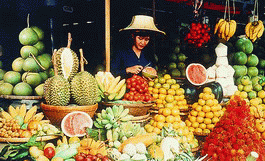
It is not simply because of its geographical position as a tropical country that Thailand produces so many different kinds of fruits of good quality. The tropical climate is certainly favourable to the growth of vegetation. But there are other factors that have contributed to the rich production – the fertile soil, the introduction of new species from foreign countries, the continued efforts to improve the quality of fruits by scientific methods, and the comparative length of Thai territory, which extends right into the subtropical zone, making it possible to grow fruits native to places of higher latitudes.
Here is a brief introduction to several kinds of fruits produced in Thailand that are worth special recommendation. Names in Thai with their romanized spellings are given after the English names of facilitate the identification of the fruits. Prices given are just rough indicators. The actual prices may vary according to the season, the harvest and where the fruits are bought.
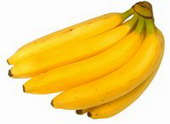
Banana (kluai), there are 3 main species: 1. The fragrant banana (kluai hom), most palatable and most commonly eaten by foreigners; 2. The namwa banana (kluai namwa), either eaten raw as fruit or cooked in many different ways and eaten as a snack; and 3. The egg banana (kluai khai), small in size with a thin skin, a specialty of Kamphaeng Phet Province. Season: All year round.

Coconut (ma-phrao) Only the young ones are eaten as fruit. Scoop out the tender meat with a spoon and drink the refreshing milk with a tube. Season: All year round.
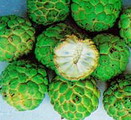
Custard Apple (noi-na) Transplanted from Central America long ago. Easily broken with a squeeze. Eat the soft, white meat with the help of a spoon and leave out the seeds. Season: June to August.
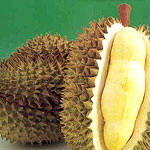
Durian (thu-rian) A very special fruit. Reputed to be the king of all fruits, its strong smell sometimes turns people away before they have a chance to taste it. However, if one can overcome one’s initial dislike of its foul smell and give it a try, one is likely to love its rich, unique flavour.
Among the various species, the golden pillow (monthong) is most agreeable to the beginner.Other famous varieties include the long-stemmed (kanyao) and the gibbon (cha-ni). Season: May to June.

Grape (a-ngun) First transplanted from Europe about a century ago, it has thrived for the past two decades after new varieties suitable to the tropical climate were developed. Both the green and the red varieties are available. Season: December to April.
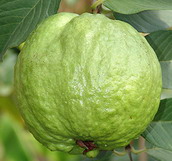
Guava (farang) The Thai name means a White or a Westerner. The fruit derived its name because it originated from tropical America. It has become a popular fruit only after the new Vietnamese species was widely planted more than a decade ago. Eat the white, crisp flesh either alone or with the condiment provided free by the vendor. Don’t eat the core, which would cause constipation. Season: All year round.
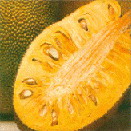
Jackfruit (khanun) Somewhat like a durian but even bigger, it takes an expert to open it with a sharp knife. But people usually don’t buy a whole fruit. The vendor will open it and take the yellowish flesh out for retail. Its large seeds are edible after being boiled, and are nutritious too. Season: Almost all year round.
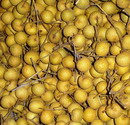
Longan (lamyai) Brought into this country by Chinese immigrants hundreds of years ago, it was first planted in Bangkok and then in the North. It is in the North that the fruit has flourished and become one of Thailand’s largest export fruits. The most famous species is the pink longan produced in Chiang Mai. Its flesh is pinkish and thick and delightfully sweet. Season: May to July.
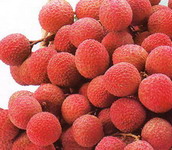
Lychee or Litchi (linchi) Also transplanted from South China, but much later than the longan. Now, it is widely grown in Chiang Mai and other northern provinces and is just as good in quality as the fruit produced in China. Its slight tartness gives its sweet pulp a unique taste. Season: April to May.

Mango (ma-muang) Like the persimmon, the mango can be eaten both ripe and unripe. Some varieties are best eaten ripe and some others, unripe. The former includes namdokmai and okrong, and the later, the khiao-sa-woei and nangseam. The Thais are fond of eating ripe mangoes with sticky rice and coconut cream. It is sold everywhere when the fruit is in season. You should give it a try. Season: March to May.
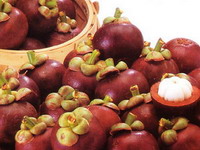
Mangosteen (mangkhut) Cut open the thick dark red rind with a sharp knife. Be careful not to let the sap contained in the skin stain your clothes, which would leave marks hard to remove. The white juicy pulp is divided into 5 to 8 segments, of which 1 to 3 contain a seed. The sweet flesh has a delicate texture and will melt in your mouth. Season: May to July.
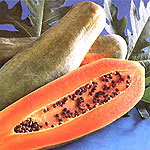
Papaya (malako) Originating from tropical America, the plant has been grown in this country for so long and so extensively that the Thai people tend to consider it a native of their land. It is easy to grow and highly productive. That is why it is among the cheapest. But don’t judge its quality by its price. The former is out of proportion to the latter. Slice it lengthwise and eat it with a spoon, or remove the skin and eat with a fork. A squeeze of lime juice will enhance its taste. Season: All year round.

Pineapple (saparot) Sweet, succulent and rich in vitamin C. Add a little salt to enrich the flavour. Largest plantations are in Prachuap Khiri Khan and Phuket in the South, Chon Buri and Rayong along the eastern coast, Prachinburi near Cambodia, and Lampang in the North. Most of the fruits are canned and exported. This serves to prove the excellent quality of the pineapples produced in this country. Season: All year round.
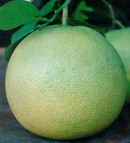
Pomelo (som-o) The Siamese pomelo was well known in the native country of the ethnic Chinese in Thailand decades ago. In fact, that was about the only Thai fruit known to their relatives at home. Although that was partly because the pomelo is more durable than most other fruits and can endure a long sea voyage without perishing, it is an undeniable fact that the Thai pomelo has earned fame for its country for long. The fruit is easier eaten than peeled. But the good taste is certainly more than worth the effort. Anyway, the vendor can do the job for you free of charge. Season: August to October.
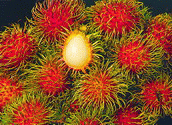
Rambutan (ngo) In bright red with yellowish or greenish hair, the rambutan is beautiful in appearance. Its white flesh is firm, sweet, and juicy. The most widely grown species are the pink rambutan, the school rambutan and the che-mong. If you find that the meat does not come off the seed readily, you may use a knife to help. Season: May to June.
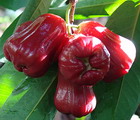
Rose Apple (chomphu) Another lovely fruit mostly in light green. Shaped like a bell, it can be eaten whole after the hollow end is cut off and a few tiny seeds inside removed. The fruit is crisp and succulent and only slightly sweet. Thais often eat it with a sugar-pepper condiments or nampla wan sauce to add to its taste. Season: May to June.
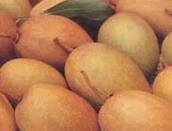
Sapodila (la-mut) Similar to an egg in shape and size, but not in colour. Pare off the thin brown skin, slice it lengthwise into 4 or more sections to remove its few seeds, which are flat, hard and in jet black, and eat the sweet pulp with a fork. Season: All year round.
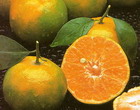
Tangerine (som) Much improved in taste and texture in the past few decades. Formerly, only those grown in Bangmot district in the outskirts of Bangkok were famous. Now, orchards in Samut Sakhon, Rayong, Chanthaburi and Chiang Mai also produce tangerines of high quality. Season: All year round.
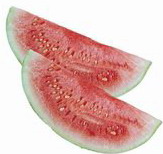
Watermelon (taeng-mo) The large round fruit has a hard green rind, a watery red pulp and small brown seeds. It provides plenty of not-too-sweet water and is an ideal fruit to eat when you are thirsty. Its quality is by no means inferior to any famous species produced in other countries. Season: All year round.
There are many, many other fruits produced in this country. Indeed, it is no exaggeration to call Thailand the kingdom of a hundred fruits. Those not mentioned above may be less well known. Yet they each have their special flavour liked by some at least. As you can see from the above, May and June are the two months when most of the famous fruits are on sale in Thailand. You are fortunate if you happen to be in this country during this period. If not, do try to come before the end of summer in order to claim the bonus which is waiting for you to collect. (http://www.thaiwaysmagazine.com)




